We're delighted to welcome our guest blogger Nancy Dunitz, the founder and designer behind Dunitz & Company. Like Mayan Hands, Nancy has been collaborating with Mayan artisans in Guatemala for more than 30 years. Her creative work has touched and connected the lives of so many women - from her artisan partners to her many wholesale and retail customers who enjoy her original designs. We've gotten to know each other well as fellow members of the Fair Trade Federation (FTF) and recent conversations about the design process led to her thoughtful blog post. Read on to learn about how different fair trade organizations, all FTF members, design collaboratively with their artisan partners. We celebrate the good work of our good friends from Dunitz & Company, Mayamam Weavers and Yabal.

For this blog post, I reached out to a few other designers that work in Guatemala. The companies these women are affiliated with are all members of Fair Trade Federation. I know these women have all worked tirelessly to build a market for Guatemalan artisans. Each has their own story. I asked them if they'd be willing to share a story about their journey with me. Lucky for us, they all said yes. I asked them a series of loose questions. And then it was left up to them, how they wanted to answer my inquiries. Keep reading. First I'll share my questions. And then you can learn more about these amazing fair traders. And, yes, lastly, I'll share a story from my Dunitz & Company experiences.
NANCY: Please respond to whichever question or part of my inquiry gives you joy or might be interesting to those that read my blog post. How did you get involved with designing and collaborating with artisans in Guatemala? Do you have a favorite design? Can you tell me about it? Or one that has a fun story behind it? Definitely tell me about an item where I can share the link for purchase.
ANNE KELLY from Mayan Hands:Thank you so much for asking about design, because it's such an important and fun part of our work. Mayan Hands has been partnering with Mayan women artists for more than 30 years. The design process has always been collaborative, and supporting the women in preserving the culture they cherish, especially as expressed in their textile traditions, is part of our mission. The gorgeous textile techniques and the colors that Guatemala is known for makes the process exciting. For me, the very best part is when we are able to work alongside one another. We are often working with many layers of language (English to Spanish to Kaqchikel or Tz'utijil or K'iche or A'chi), but it's the common language of handwork that forges deeper connections. As we sit together, we talk about our lives, our families, our hopes and dreams - and yes, the designs as well.
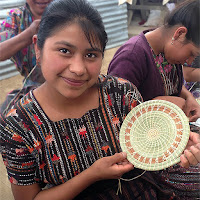 I'm always inspired by the creativity of the women, and their willingness to stretch their imaginations and their skills. One example is our collection of beautiful pine needle baskets. A few coops of weavers and embroiderers learned the basics of basket-making, and the women took their newly acquired skills to amazing places, infusing the baskets with motifs and symbols also seen in their weaving. Periodically, we put out a call for new designs, sort of a basket competition. Anything goes! The women are paid for their submissions and prizes are given for the winning designs. Of course, the best prize is when a new design goes into production (sometimes after tweaks), bringing more work and income to everyone in the coop.
I'm always inspired by the creativity of the women, and their willingness to stretch their imaginations and their skills. One example is our collection of beautiful pine needle baskets. A few coops of weavers and embroiderers learned the basics of basket-making, and the women took their newly acquired skills to amazing places, infusing the baskets with motifs and symbols also seen in their weaving. Periodically, we put out a call for new designs, sort of a basket competition. Anything goes! The women are paid for their submissions and prizes are given for the winning designs. Of course, the best prize is when a new design goes into production (sometimes after tweaks), bringing more work and income to everyone in the coop.
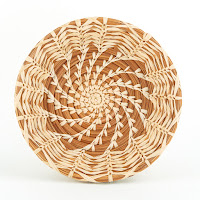
It's hard to choose a favorite design - there are so many! I love our Catarina Basket. The group that makes it came to us several years ago looking for work. They had some basic basket making skills, but didn't yet have the quality and consistency we required. They began working with us by making simpler designs so they could earn income while honing their skills, then advanced to making more technically challenging baskets. When they submitted this basket after a call for new designs, we knew immediately it was a winner (and indeed, it's a bestseller). We named it after the woman who made the first sample. The stitches, all perfectly executed, give the basket a beautiful energy that everyone loves. Now this coop is one of our strongest and some of the women have gone on to teach other groups, a great ripple effect.
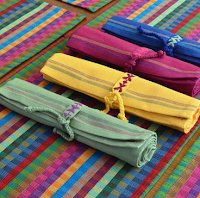
CARYN MAXIM & JENNIFER WEBSTER from Mayamam Weavers- Mayamam Weavers works with one women's weaving cooperative in the western highlands of Guatemala. Our product design strategy is a collaboration between the cooperative and our small team here in the United States. In the U.S., we understand the market better and know what products may successfully sell. In Guatemala, the women have the talent and skills to weave beautiful textiles, skills that have been handed down from their ancestors. A fun example of how we have truly come together to create a successful product is our popular Cuadritos line of table linens. It began as a request to our backstrap weaving team to weave a square in whatever pattern wanted, to create a kind of "sampler" of their skills. Here in the U.S., we studied each of their squares. We selected the weave they called Cuadritos (which means "small squares" in Spanish) and asked the foot loom weavers if they could interpret it on the foot loom. Our Jeweltone Cuadritos design came out of that interpretation. It has turned out to be a wonder fabric. Sewn into placemats and table runners, the fabric is unbelievably easy to care for. Not only is it washing machine friendly, when you take it out from the dryer, it doesn't even need ironing. It comes out completely ready to adorn your table! Since Cuadritos was so well received, we have since introduced two additional color combinations, Blue Moon and Champagne & Pearls.
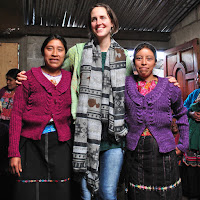
ALLISON HAVENS from Yabal -I came to Guatemala in 2011 after having worked in a fair trade store in Chicago for several years, looking for a change of scenery and work. I worked as a Volunteer and Activity Coordinator at a womens and childrens domestic violence center in Quetzaltenango for my first three years in Guatemala. However, I soon became frustrated with the lack of options for these families to maintain their economic independence from their abusers and the overall lack of work options for uneducated women in Guatemala. This experience brought me back full circle into the fair trade worlds as I connected with the local women's fair trade organization Yabal. I began working with them in 2012 to build up their business and sales, and have been with Yabal since. The mission of Yabal is to support rural women artisans through consistent, well paid, respectful artisan textile work. The impact is real, tangible, and immediate for the women and their families we partner with. It's incredible to see how this type of work and equitable business relationship changes lives and builds confidence in the women that have worked with Yabal for many years.
I didn't start off designing products for Yabal but the nature of the work led me to try my hand at product design. There is so much local competition for artisan goods in Guatemala that unique designs and quality crafts(woman)ship are one of the only ways to set yourself apart and continue providing for work for our weavers. I have a background in studio art, but product design was overwhelming for me. Yabal's weavers have the ability to create hundreds of incredible pattern and color combinations. It's almost impossible to limit the design possibilities into just one "collection." I usually have an impulse to include every design and every color option in our collection because they're all gorgeous. It's just not possible.
When creating Yabal designs, we always use one of the women's own weavings as a base and jumping-off point. A lot of times, it's really about choosing a certain color palette and paring down the number of color combinations used so that the design is more attractive to trends in a foreign market. We seek to maintain the identity of the weaving designs and of the communities where they come from while adding a bit Western design influence. Usually the process is a very collaborative effort and we take our design lead from the incredible master artisans we partner with.
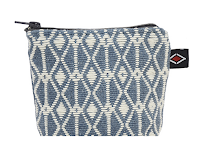 One of my favorite products is the Maya Coin Purse. This product is an example of not wanting to completely narrow down and standardize the design; allowing some spontaneity and creativity up to the weavers. Because of this, each of these purses features a difference brocade design using traditional Maya geometric patterns. This makes each purse an original artwork created by each weaver. While the design patterns will vary with each purse, the colors are standardized and simplified. When stores purchase several of these coin purses, the variations shipped allows customer to choose a design that is completely unique. And even better, the threads for our coin purses are artisanally dyed using all natural plants and minerals by another women's cooperative.
One of my favorite products is the Maya Coin Purse. This product is an example of not wanting to completely narrow down and standardize the design; allowing some spontaneity and creativity up to the weavers. Because of this, each of these purses features a difference brocade design using traditional Maya geometric patterns. This makes each purse an original artwork created by each weaver. While the design patterns will vary with each purse, the colors are standardized and simplified. When stores purchase several of these coin purses, the variations shipped allows customer to choose a design that is completely unique. And even better, the threads for our coin purses are artisanally dyed using all natural plants and minerals by another women's cooperative.
Nancy: That was fun and informative for me to read these stories, and to see how these women interpreted my questions. And I supposed you might want to hear some tales from me now: )
NANCY DUNITZ from Dunitz & Company -I launched my business in 1989 after traveling to Guatemala to explore the possibilities of working with and collaborating with artisans there. There were a number of foreign nationals living in Guatemala at the time, all willing to introduce me to the members of their community and various Mayan artisans they knew. At the time, one of the only ways to get around Guatemala was by public bus. I fortunately was able to hire a private driver who took me to many remote villages where I was able to meet many artisans and see their work first-hand. I was also told about an American woman living in Guatemala who was working with and showing Mayan woman how to create bead-work. (Beading is not indigenous to Guatemala.)Initially, and unsuccessfully I had tried to connect with her on one of my trips to Lake Atitlán.
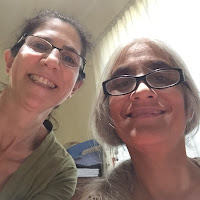 Here's my quirky story. And it probably is more quirky for my now longtime friend and colleague, Suri. I think it was my second time ever exhibiting at the Los Angeles Gift Show. She walked into my booth and introduced herself. Her mom was living in Los Angeles at the time, and she'd come to visit her. And while she was in town, she managed a pass to check out the trade show. That is when and where the seeds of our collaborations sprouted. More amazing, the exhibitor next to me, who designed clothing from Guatemala, was married to Suri's half sister, a woman she had never met until that day. Her sister had grown up in Mexico, and only by chit-chatting with my neighbor did they make that connection. She has always repeated that that was one of the most meaningful days of her life. She met her sister. And she met me. Wow. Right?
Here's my quirky story. And it probably is more quirky for my now longtime friend and colleague, Suri. I think it was my second time ever exhibiting at the Los Angeles Gift Show. She walked into my booth and introduced herself. Her mom was living in Los Angeles at the time, and she'd come to visit her. And while she was in town, she managed a pass to check out the trade show. That is when and where the seeds of our collaborations sprouted. More amazing, the exhibitor next to me, who designed clothing from Guatemala, was married to Suri's half sister, a woman she had never met until that day. Her sister had grown up in Mexico, and only by chit-chatting with my neighbor did they make that connection. She has always repeated that that was one of the most meaningful days of her life. She met her sister. And she met me. Wow. Right?
You can only imagine the voluminous number of designs and color combinations we've created together over our tenure. There was a time when we'd introduce 60 or more new designs twice a year. And each season everything would be created in 12 new color combinations. As the women who created our beaded jewelry became more proficient and confident, they'd often present to us designs that they had thought up. Often these became part of the Dunitz & Company beaded collection. Those early days were crazy. We had created a huge demand for bead-work, we had our clandestine workshop, and we hadn't yet been copied. I used to exhibit at 16 wholesale trade shows each year. Can you imagine?
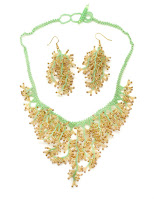
So, where did it all begin? Our beaded Coral Necklaces and Coral Earrings were first introduced nearly 30 years ago. And they still sell well. They say emulation is the sincerest form of flattery. That's a tough one for me to swallow. If my ego got in the way on this one, I would have retired this design a long time ago. Many other companies have created their version of what we do. Thankfully, over the years our wholesale customers seem to appreciate our quality and color combinations. Our coral jewelry always feels soft and flows easily. This design has actually been featured on multiple mail-order catalog covers!
Coming up with ideas for blog posts is often challenging. And as many of you know, I often like to support my fair trade colleagues by sharing what they are doing and/or writing. This post is no different. I wanted to take my hat off to Anne Kelly, Caryn Maxim, Jennifer Webster and Allison Havens who are doing an amazing job of creating opportunity for artisans in Guatemala. We all work endlessly and being recognized for a job well done can go a long way. So, you go girls! And when you need a beautifully made, fair trade gift, please consider one of our designs. Their links are above. And of course, Dunitz & Company's fair trade jewelry is also only a click away.










Leave a comment (all fields required)